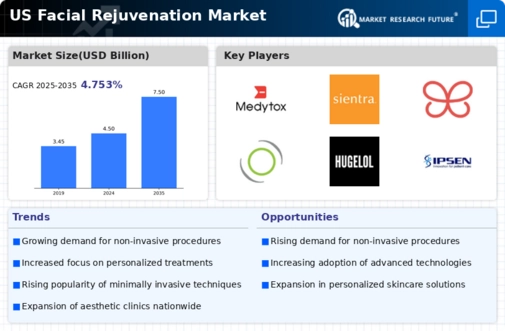Increasing Demand for Aesthetic Procedures
the facial rejuvenation market is seeing a surge in demand for aesthetic procedures, driven by a growing societal emphasis on physical appearance. As individuals increasingly seek to enhance their looks, the market for non-invasive and minimally invasive treatments expands. In 2025, the market is projected to reach approximately $15 billion, reflecting a compound annual growth rate (CAGR) of around 10% over the next five years. This trend is particularly pronounced among younger demographics, who are more inclined to invest in facial rejuvenation treatments. The rising acceptance of aesthetic procedures as a norm contributes to the growth of the facial rejuvenation market, as consumers prioritize self-care and personal grooming. Furthermore, the increasing availability of various treatment options, including injectables and laser therapies, caters to diverse consumer preferences, thereby bolstering market expansion.
Rising Disposable Income and Consumer Spending
the facial rejuvenation market benefits from rising disposable income levels among consumers in the United States.. As economic conditions improve, individuals are more willing to allocate a portion of their income towards personal care and aesthetic enhancements. In 2025, it is estimated that consumer spending on beauty and wellness will exceed $100 billion, with a significant portion directed towards facial rejuvenation treatments. This increase in disposable income allows consumers to explore a wider range of treatment options, from advanced skincare products to high-end cosmetic procedures. Consequently, the facial rejuvenation market is likely to see a diversification of services offered, catering to various income brackets and preferences. This trend suggests a robust growth trajectory for the market, as more consumers invest in their appearance and overall well-being.
Aging Population and Demand for Anti-Aging Solutions
The aging population in the United States significantly influences the facial rejuvenation market, as older adults increasingly seek solutions to combat the visible signs of aging. With approximately 20% of the U.S. population projected to be over 65 by 2030, the demand for anti-aging treatments is expected to rise correspondingly. This demographic shift creates a substantial market opportunity for facial rejuvenation services, as older consumers often prioritize maintaining a youthful appearance. the facial rejuvenation market is likely to benefit from this trend. Revenue from anti-aging treatments could account for over 40% of total market sales by 2025.. As a result, service providers are adapting their offerings to cater to the specific needs of this demographic, further driving market growth.
Advancements in Treatment Technologies and Techniques
the facial rejuvenation market gains from continuous advancements in treatment technologies and techniques that enhance the efficacy and safety of procedures.. Innovations such as improved laser technologies, advanced injectables, and non-invasive devices are transforming the landscape of facial rejuvenation. In 2025, the market is expected to witness a surge in the adoption of these cutting-edge technologies, which could lead to a 15% increase in treatment efficacy and patient satisfaction. As practitioners adopt these advancements, they can offer more effective solutions with reduced downtime, appealing to a broader audience. This trend indicates a shift towards more sophisticated and personalized treatment options, which are likely to attract consumers seeking optimal results. Consequently, the facial rejuvenation market is poised for growth as technology continues to evolve and reshape consumer expectations.
Influence of Celebrity Endorsements and Public Figures
the facial rejuvenation market is influenced by celebrity endorsements and the visibility of public figures discussing their aesthetic treatments.. As celebrities increasingly share their experiences with facial rejuvenation procedures on social media platforms, public interest in these treatments grows. This phenomenon not only normalizes the use of aesthetic procedures but also drives consumer curiosity and demand. In 2025, it is anticipated that marketing strategies leveraging celebrity endorsements will account for a significant share of advertising expenditures in the facial rejuvenation market. The aspirational nature of celebrity culture encourages consumers to seek similar enhancements, thereby propelling market growth. As a result, brands and service providers are likely to invest heavily in partnerships with influencers to capitalize on this trend, further expanding their reach and appeal.



















Leave a Comment